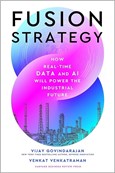- Strategy
Industry Beyond Digitization
Two renowned authorities on strategy and innovation explain how the fusion of physical products and services with real-time data and AI will shape the industrial future
Data driven technologies enhanced by AI, which have revolutionized the asset-light world of media, information, and entertainment businesses, are now beginning to transform the way we use and think about the vast range of physical products and services delivered by traditional industries such as manufacturing, logistics, construction, and healthcare. To avoid being pushed aside by start-ups and insurgents, as happened with the media sector, now is the time for incumbent business to rethink the future.

Vijay Govindarajan (VG), co-author with Venkat Venkatraman of Fusion Strategy: How Real-Tine Data and AI Will Power the Industrial Future, dedicates the book to his three small grandchildren, saying it is they “who will most appreciate this book.” I think he may be wrong. By the time these digital natives can understand it they may not need it, as its meaning will be second nature to them. In the next decade alone AI will bring massive and profound changes. The question is do business leaders currently in place really appreciate the scale of what is happening, and do they have the strategic insights to take advantage of the many opportunities ahead?
In recent years while the titans of Silicon Valley have flourished on the back of their ability to gather and exploit data from billions of users, companies in manufacturing, construction, and many service industries have largely been left behind. Technologies move on rapidly. Today the availability of cheap and powerful sensors, computing power, and AI provides the opportunity for physical products to be infused with digital intelligence—to use algorithms and AI to analyze untold amounts of rich data to make previously implausible levels of strategic connection.
With Fusion Strategy, professors Govindarajan and Venkatraman have produced an invaluable guide for the thousands of perplexed business leaders in asset-heavy industrial companies, currently grappling with the potential for the fusion of the digital and the physical. Companies that are considering not only how to produce outstanding machines but how these machines can satisfy the specific needs of individual customers.
Using real examples from Tesla, John Deere, Honeywell, Google Mineral and from gene editing, the authors outline four fusion-strategy ‘battlegrounds’:
- The battle for brilliant machines (the future of mobility);
- The race for remarkable results (the linking of products to additional customer services);
- The showdown of smart systems (the creation of smart cities and optimal environments); and
- The clash of custom solutions (the potential of radical applications).
While these battlegrounds will develop and shift over time and affect industry sectors differently, understanding them can help business leaders envision the vast untrammeled fusion landscape ahead. It can provide a template for formulating strategies to unlock new value and take competitive advantage of the opportunities provided by the changing technologies.
As well as a clear vision, leaders will need to foster innovative cultures in their organizations and acquire new skills through training and savvy recruitment. Then as detailed by professors Govindarajan and Venkatraman leaders must take their companies, in each battleground, through a regenerative cycle of four sequential steps: architect; organize; accelerate; and monetize. The potential rewards are great, but it is happening now, and it will be very easy to get left behind.
The fable of the Last litho-printer in Leicester—who profited for a couple of years while his competitors struggled with the new digital technology—might apply for some, but don’t count on it. Think more of the fates of Kodak and Blockbuster.
…………………………………………………………………………………………………………………………….
ARTICLES YOU MIGHT LIKE
BOOK REVIEW
A provocative new book reveals the downside of strategic and organizational change and the benefits of stability
DEVELOPING LEADERS QUARTERLY MAGAZINE AND WEEKLY BRIEFING EMAILS

































